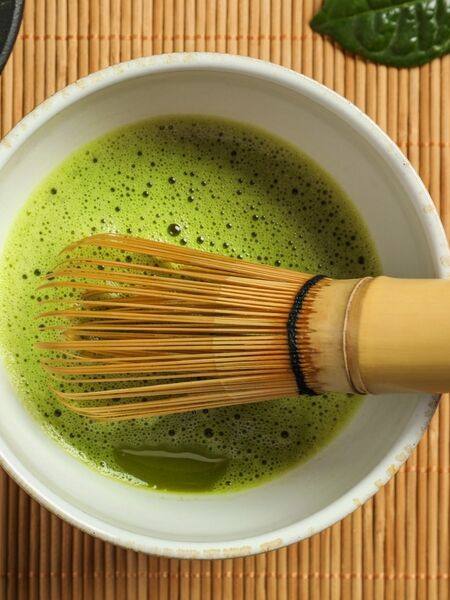Matcha Sales Yield Spring Profits

Nothing says spring like flowers blooming, snow melting (some places!) and the arrival of this year’s flavorful, fabulous matcha.
This fantastic Japanese green tea, the only tea that uses the entire leaf and stem, is a powdered tea that originates as gyokuro, the finest of the country’s exceptional greens. You’ll want to shore up your display with beautiful signature wide bowls in which customers can make the tea, along with classic bamboo whisks for an energizing, luxurious tea-drinking experience.
Share Information Everywhere
Like all events, products or services, share the news of matcha’s arrival, and that of its preparation accessories, everywhere: your website, handouts in sales bags, in-store signage, window displays, and via one-on-one conversations between sales staff and customers.
Here are some other ways to promote this spring’s harvest:
Offer an In-Store Matcha Tea Tasting
One sip, and you’ll convince anyone this is the tea experience to enjoy every morning (or anytime.) By hosting demonstrations of how the utensils and tea bowls are used, how much tea to serve per portion, customers will quickly understand how easy it is to prepare, and how they can prepare matcha at home, with or without the traditional utensils, although the right utensils do indeed make a finer cup.
If at all possible, invite a cha-no-yu teacher to host the event along with you. That adds excitement and the cachet of additional authority, especially if they are from an accredited Urasenke School. Also, many DVDs and youtube.com instructions are available and you can have them on a loop near the display of matcha teas and preparation tools.
Check with your local bookstore or library for a suggested list of books on cha-no-yu for those customers totally intrigued with this unique tea drinking experience.
Print Out Matcha Preparation Directions
It hardly takes any practice at all, but this time-honored method makes great-tasting matcha each and every time.
- Heat water to 160-180 F.
- Measure out a small level teaspoon (or to taste) into a bowl.
- Add just a few drops of the heated water to whisk the matcha powder into a paste.
- Add enough water, about 1/2 cup.
- Steep for about 2 minutes then whisk into a froth taking care to move the whisk in a sideways back-and-forth motion or as if you are making the letter W or M. This helps the powder be fully incorporated with the hot water into a smooth and silky beverage.
The resulting cup should have a light foam, be bright green in color and tastes both grassy and creamy, sweet and vegetal. Remind customers that their palate is the final judge, so adding more or less tea, steeping longer or shorter times are options for the ultimate in tea tasting pleasure.
Drink up fresh spring flavor!
Switch Bottled Water to a Travel Tumbler of Matcha
You can easily “cold brew” matcha in clean, cool spring water then pour into a travel tumbler. That way, you can savor this beverage a few sips at a time all day long. No matter what the capacity of your thermos, consider making only about 8 oz. of matcha as its stimulants are strong. REMEMBER, always shake the thermos vigorously before drinking the matcha. That way you’re sure to have the taste pleasure of the sweet foam and a fully and completely incorporated beverage of matcha powder and water. Yum!
NOTE: A little goes a long way as matcha is high in both L-Theanine which offers clarity to the brain and calm to the body and caffeine which offers energy, but unlike coffee, rarely contributes “the jitters.”
Suggest Alternative Utensils
While Japanese utensils are thoughtful and exceptionally useful in matcha preparation, and increase the level of tasting pleasure, it is possible to prepare it using common kitchen utensils found in most homes:
Small strainers for sifting the matcha powder to eliminate any lumps
Wide-mouth bowls for whisking up the tea
Frother or bamboo whisks for whisking
Jars or canisters for storage
Share the History and How-To
Matcha facts are fun! Do share some or all of the following “factoids” in your sales pitches and handouts or on your website. Here are just a few ideas:
Our premium-grade matcha comes from the finest farms in the Uji Province of Japan, known as the epicenter for the tea served in the Japanese tea ceremony, Cha-no-yu.
How matcha is made is completely different than any other tea, including other Japanese green teas. Gyokuro is shaded for several weeks before harvesting to elevate the amount of fragrance and flavor. The shading increases the chlorophyll that also provides the gorgeous Kelly green color. The leaves are carefully harvest, the leaves are deveined, and this step results in “tencha”, a tea ready for the final step: complete drying then grinding with stones into a powder.
A Matcha Preparation Vocabulary
Tencha: the leaves before the tea is ground into a powder
Matcha: the resulting powdered tea
Chasen: bamboo whisk for mixing the tea into a frothy sweet-green flavor. The finest ones have 80 prongs to assure even distribution of powder in the water.
Chasen Holdert: usually made of ceramic, this holds the bamboo after use to keep its shape and to help it dry
Chawan: the wide-mouth tea bowl used for preparing matcha
Chashaku: bamboo utensil used to scoop out a portion of matcha
Tall Cup: a holder for the utensils
Matcha Strainer: for sifting out lumps of the powdered tea so that the frothing is silky and smooth
Cha-no-yu: the ancient tea ceremony originating in Japan in which matcha is served, and a/ strict protocol for both guests and host is observed.

